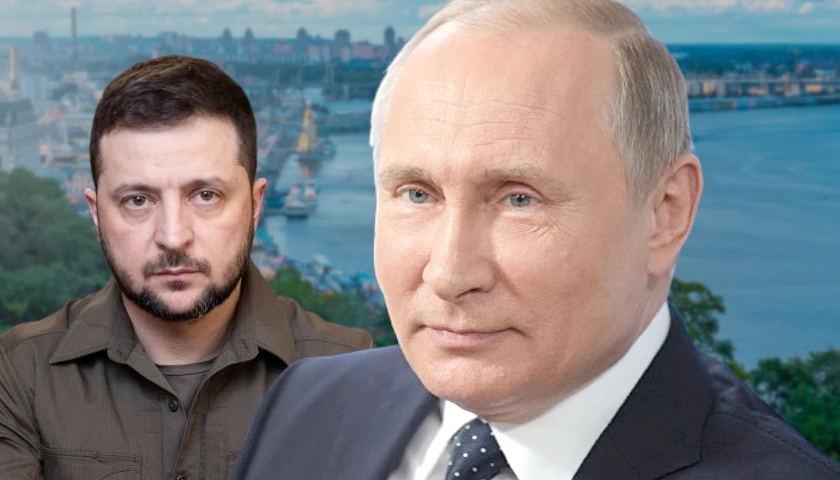by Christopher Roach
In a story that deserves more attention, Ukraine recently attacked a Russian early warning radar facility designed to detect nuclear attacks. This insane action conferred no military advantage on Ukraine—the station monitored potential launches in the Middle East—but it carried with it the risk of igniting a nuclear war. From the perspective of the country being attacked, the only reason to attack an early warning system would be to blind one’s enemy as a prelude to a nuclear attack.
Nuclear war is the most dangerous game. It means the end of civilization. If this horror show ever comes to pass, it is likely more than half of the people on our planet will die. Many console themselves that they’ll die instantly and that most of the consequences will borne by others, but no one can be sure.
Even with such cold comfort, many will survive, at least for a time. They’ll survive disfigured, injured, poorer, hungrier, and sicker. And they will do so in a new world where things we take for granted like clean water, electricity, medical care, and basic law and order are all absent. But they will be alive, and they will try to remain so.
Nuclear Forgetfulness
Unfortunately, rational fear of nuclear war is not as much a part of the public consciousness as it once was. Generation X and Baby Boomers both grew up worried about nuclear conflict. They did “duck and cover” drills in school and saw footage of nuclear tests on television. They had a sense of the scale of the risks from books like Alas Babylon and influential films like Dr. Strangelove, War Games, and The Day After.
When the Cold War ended, it was a great relief, especially in the West. We were told the world was still dangerous, but it didn’t feel as dangerous as it did when a hair-trigger nuclear posture prevailed between the United States and the Soviet Union.
Conflicts in Iraq, Afghanistan, or Serbia did not carry the same existential risk that prevailed during the Cold War. Today, the risk of nuclear war is more salient, not least because of the arrival of a flotilla of Russian naval ships in Cuba. The ships include the frigate Admiral Gorshkov, which is capable of launching nuclear-tipped hypersonic missiles, along with the never-seen-before nuclear submarine Kazan.
While ostensibly there to conduct naval exercises, the visit has a whiff of the Cuban missile crisis and its risky nuclear brinkmanship. This situation has understandably alarmed many Americans. We are used to being invulnerable and impressing others with our military power. We even direct our naval ships into the Black Sea. We are definitely not used to hostile, nuclear-armed vessels patrolling off of our coasts.
Here, our collective anxiety makes some sense. Being so close to the United States, any of these ships could launch nuclear missiles in order to destroy command and control systems and decapitate our national leadership. Russian hypersonic missiles would take twelve minutes or less to reach Washington, D.C.
Russia Is Sending a Signal
This visit takes place in parallel with a proxy war in Ukraine, in which the United States and other NATO countries have supplied training, intelligence, and arms and ammunition in order to weaken Russia and its armed forces.
Weakening is an anodyne word that does not convey the full gravity of what is taking place. We are trying to kill Russians and destroy their military. We have had some success in doing so, and we have not made any secret about it. This is understandably very provocative to the world’s largest nuclear power, even if one condemns Russia and its invasion of Ukraine.
The Russian flotilla’s visit appears to be an intermediate step, one designed to communicate a message: we can hurt you too. It is too public to be the foundation of a sneak attack.
But the risk of such an attack is very real. Submarines on both sides already have the potential for a decapitating first strike against the other, and this does not require any public port visits. Ordinary first strikes are deterred by the prospect of mutually assured destruction, but a submarine attack that seeks the swift removal of the leadership and command systems of the other side may occur regardless. They may occur because, if they are successful, these attacks defeat the possibility of an otherwise-inevitable retaliatory strike and thereby defeat the logic of mutually assured destruction.
More importantly, Vladimir Putin has made it clear that he views the war in Ukraine as an existential war for national survival and that Russia will do everything necessary, including using nuclear weapons, to win. He has repeatedly warned the United States and other NATO states that there are lines that we have crossed or are about to cross, which may set in motion a chain reaction that leads to the use of nuclear weapons.
Like the man who jumps from the building and says, “So far, so good,” the failure of these provocations to yield a Russian response are lulling us into a dangerous complacency. We will only know we have gone too far when a global nuclear war breaks out. We should instead steer clear of such risks and maintain an ample margin for safety.
A War No One Wants
The recent authorization for Ukraine to use western weapons for deep strikes within Russia proper accords with American military doctrine. This doctrine calls for disruptive and deep attacks against enemy logistics hubs and command and control infrastructure. This is a well-supported conventional strategy, but, even during the Cold War, western planners never fully accounted for the risk of provoking a nuclear response.
This boomerang effect does not depend on one or the other side’s inherent ruthlessness; rather, it arises from ordinary fear and confusion about an adversary’s intent. As Barry Posen argued in his Cold War-era study Inadvertent Escalation, “confusion about the relationship between conventional and nuclear war can lead to situation in which Western conventional and nuclear forces work at cross purposes.” In such a scenario, we or Russia do something that we consider conventional, proportionate, normal, and non-nuclear, but the other side perceives it quite differently.
For example, an American or proxy attack on a navy base or airport using conventional weapons may seem a far cry from a nuclear threat, but what if one or more planes at the airfield is an early warning plane or a nuclear-capable bomber? The party being attacked may reasonably wonder if the real intention is to defeat its nuclear retaliatory capability.
This is one of the paradoxes of conventional conflict between nuclear powers: tactical and operational victories using conventional weapons can lead to perceptions that it is time to “use it or lose it” for nuclear weapons.
The incremental escalation of the Ukraine War flows logically from the American doctrinal emphasis on deep strikes to disrupt enemy logistics. I wrote before the war began, “It’s not clear that the United States would keep any conflict over Ukraine confined to the borders of Ukraine. After all, Russian logistical depots, strategic reserves, and manpower are located in Russia proper. Avoiding them in conducting warfare would give Russia’s substantial conventional capability even more power than it would otherwise have . . .” Yet here we are. Ukrainian missiles have not only sunk Russia’s capital ships and been directed at civilian areas of Moscow, but now are being directed at Russia’s critical nuclear early warning radar sites.
While this could be a case of the Ukrainians acting on their own, they are very much our proxy. I suspect this is actually a probing attack authorized by the United States, where public protests function as cover-enhancing plausible deniability.
Either way, this is madness. Regardless of their intentions, our leaders should be held accountable for the foreseeable consequences of their policies and the foreseeable risks that they are presently creating. Providing sophisticated long-range weapons and authorizing Ukraine to use them within Russian territory courts disaster on the biggest scale imaginable.
During the Cold War, policymakers and the public had a comparatively more sophisticated understanding that a nuclear war was a risk of such magnitude that direct confrontations between the Soviet Union and NATO had to be avoided. This approach prevailed even after acts of aggression, including the Soviet interventions in Hungary (1956) and Czechoslovakia (1968). But today a compliant media, an ignorant public, and an arrogant ruling class have combined to render the risk of nuclear war higher than it was at any point during the Cold War.
God help us.
– – –
Christopher Roach is an adjunct fellow of the Center for American Greatness and an attorney in private practice based in Florida. He is a double graduate of the University of Chicago and has previously been published by The Federalist, Takimag, Chronicles, the Washington Legal Foundation, the Marine Corps Gazette, and the Orlando Sentinel. The views presented are solely his own.
Photo “Vladimir Putin” by Kremlin.ru. CC BY 4.0. Photo “Volodymyr Zelenskyy” by President.gov.ua. CC BY 4.0.




